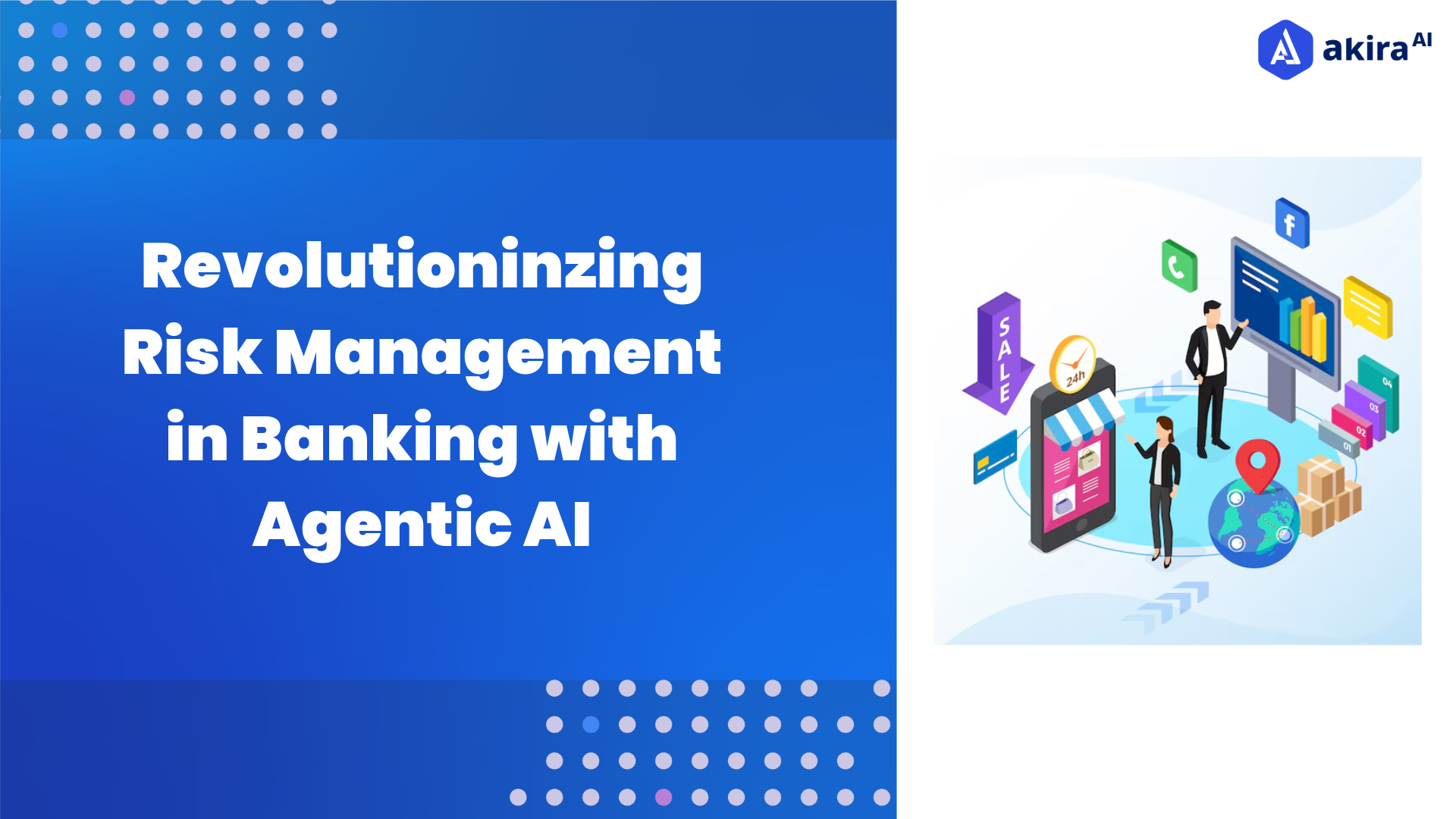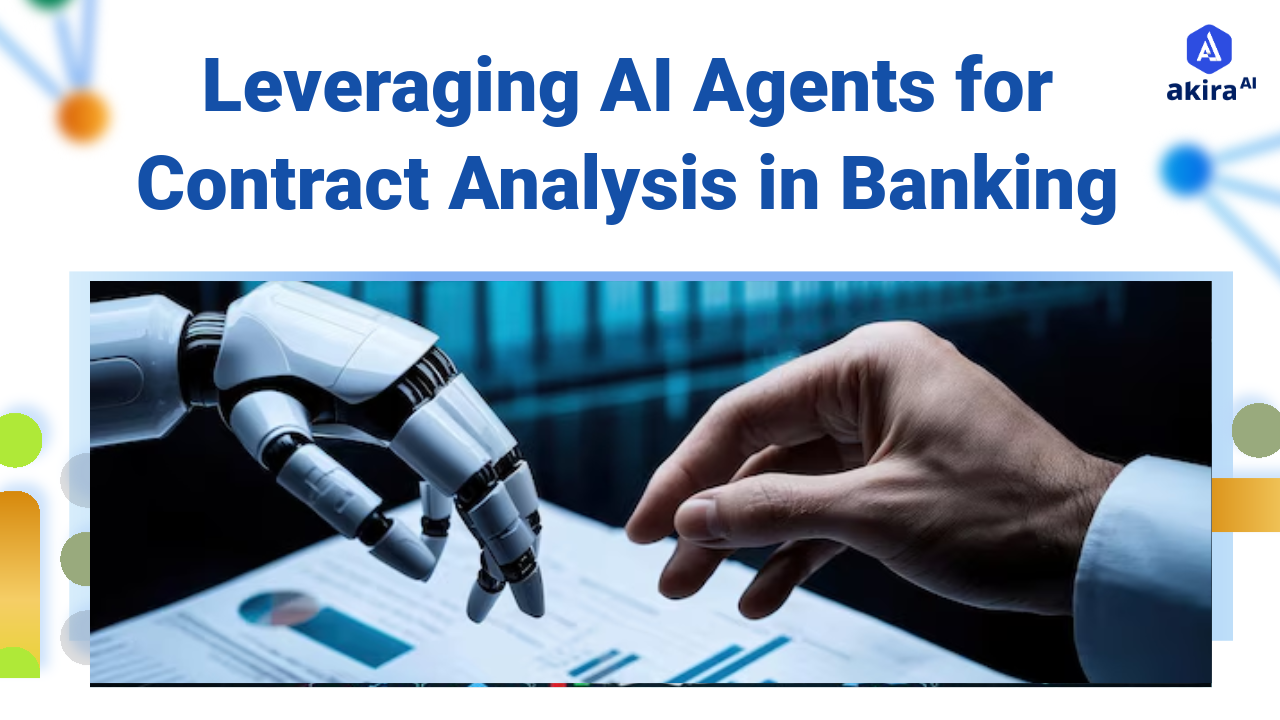Key Insights
Agentic AI is transforming loan approvals by automating traditional manual steps and creating a faster, data-driven approach to credit decisions. By utilizing intelligent agents for tasks like risk assessment, document verification through OCR, fraud detection, and compliance checks, these systems enable real-time, accurate decision-making. AI agents in Akira’s platform provide scalability, allowing institutions to process high volumes of applications seamlessly while enhancing customer satisfaction with faster responses.

Loan approval is a vital process for Banking institutions, but traditional methods often involve slow processing, manual reviews, and a high risk of errors. With the rise of AI agents and agentic AI, these challenges are being addressed through automation, making loan approvals faster, more accurate, and more efficient. Akira’s agentic AI platform helps financial institutions streamline the entire loan process, reducing human intervention and improving decision-making. This blog explores the role of AI agents in transforming loan approval, compares traditional practices to modern AI-driven approaches, and highlights the many advantages of adopting an intelligent, automated lending process.
What is Automated Loan Approval?
Automated loan approval utilizes advanced algorithms and machine learning models to evaluate loan applications, assess creditworthiness, and make approval decisions autonomously. Automating manual processes and reducing the potential for human error, it significantly accelerates the loan approval process, from initial application to final decision. This approach leverages vast datasets and sophisticated analytical models to assess factors such as credit scores, income levels, and payment histories in real-time, enabling faster and more accurate decision-making.
At the core of this innovation is Agentic AI, which deploys intelligent agents to autonomously manage various stages of the loan approval process. This technology ensures seamless operations, minimizes errors, and enhances overall decision quality, leading to more efficient and reliable loan processing.
Traditional vs. Agentic AI-driven Solutions in Automated Loan Approval
The transition from traditional loan approval methods to AI-driven solutions, particularly those powered by Agentic AI, highlights significant improvements in efficiency, accuracy, and customer experience. The table below illustrates the key differences between these two approaches:
|
Aspect |
Traditional Loan Approval Methods |
Agentic AI-driven Solutions |
|
Processing Speed |
Time-consuming, often taking days or weeks due to manual reviews |
Real-time processing and decision-making with minimal delays |
|
Accuracy |
Prone to human errors, subjective judgments, and inconsistencies |
High accuracy through data-driven analysis and algorithms |
|
Cost |
Higher operational costs due to manual labor and paperwork |
Lower costs due to automation and reduced reliance on human resources |
|
Scalability |
Limited by human capacity and labor-intensive tasks |
Highly scalable, able to handle large volumes without compromising speed or accuracy |
|
Customer Experience |
Lengthy processing times, unclear communication, and potential for delays |
Faster decisions, transparent processes, and improved customer satisfaction |
|
Risk Assessment |
Manual risk evaluations based on set criteria, potentially biased |
AI-driven assessments using comprehensive data analysis for more objective and consistent evaluations |
|
Compliance Management |
Manually tracked, subject to human oversight |
Automated, with continuous monitoring and adherence to regulatory frameworks |
|
Flexibility |
Rigid processes, slow adaptation to new regulations or market changes |
Adaptive workflows that can quickly respond to regulatory updates and market shifts |
Akira AI Multiagent in Action
-
Loan Application Submission: The process starts with a loan application supported by all the documents necessary to go along with it. It is the first step of Agentic AI use toward speeding up the approval process. The system retrieves all the information from the user and organizes them in a form fit for further analysis.
-
Document Verification When the documents are uploaded, the system will read the same through Optical Character Recognition (OCR) to extract information from the uploaded documents. It would only ensure no possibility of human error and proper information capture for further analysis. The availability of integration with OCR in the system will capture all the available information to which extent, mainly income statements and identification documents.
-
Multi-Agent System Evaluation: All the input information is fed into a multi-agent system after proper authentication of the document. Many such agents are highly specialized in very specific tasks like risk evaluation, credit analysis, and fraud assessment. The cooperative nature makes the system feasibility to analyze all those aspects of the loan application through multitudinous factors and datasets. AI agents ensure that assessments are thorough and fair and bank on large amounts of data to give fair decisions
-
Agentic Workflow Execution: With all the applications thus complying with all the relevant measures, agentic workflows have designed sending all loan applications processing. This work allows application like the form completion that would have been required in the process and ensure all documentation is complete and compliant with the regulatory requirements. This, in turn, reduces the system's processing time to remarkable margins while improving operational efficiency, thus making the experience of the user much smoother
-
Final Appraisal and Notification: Once the system has been appraised, a loan officer checks the application. This is an important quality control step as one knows for sure whether he or she will pass the requirements. Once the application gets approved, the system notifies the user about the status of loan approval. Such speedy communication essentially enhances customer satisfaction since feed and closure of the application process are received quickly.
Use Cases of Automated Loan Approval in Banking
-
Instant Approvals of Personal Loans: Real-time analysis of credit scores and income allows instant approval for loans. Such waits are significantly cut down, which in turn improves customer satisfaction.
-
Mortgage Underwriting: It also streamlines the mortgage approval process with fast credit score evaluation and property appraisal. That consequently results in quicker decisions, thus speeding up closings by a large margin.
-
SME loan sanctions: Prompt appraisals of the finance histories and growth prognoses of small and medium enterprises afford ready loan approvals. This aid enables businesses to get hold of growth opportunities without procrastination.
-
Predictive analysis: in the risk mitigation direction, for instance, using historical and economic data, there are foreseen risks of defaulting. In other words, so-called qualified borrowers are targeted on effective reduction of nonperforming loans.
-
Enhanced fraud detection: Loan application patterns and anomalies are what detect fraudulent activities. While using this method helps the lender be protected from possible losses, the integrity of approvals is also strengthened.
-
Automated Compliance Review: Regulatory compliance is meticulously monitored throughout the loan approval process, thereby minimizing risks. This automation accelerates the approval process while simultaneously ensuring adherence to legal standards.
How Does Akira AI’s Agentic AI Platform Enhance Automated Loan Approval?
-
Master Agent: The Master Agent orchestrates the entire loan approval process, coordinating the tasks of specialized agents. It integrates their outputs to form a comprehensive assessment and ensures that each step is executed efficiently.
-
Human Feedback Taker: This agent facilitates communication between the automated system and human experts. It collects valuable insights and feedback from users, enabling the system to adapt and improve based on real-world experiences.
-
Risk and Credit Analysis Expert: Focused on evaluating the financial risk associated with loan applicants, this agent analyzes credit scores, income, and payment histories. It leverages advanced analytics to assess creditworthiness and predict the likelihood of repayment.
-
Fraud Evaluator: The Fraud Evaluator meticulously checks applications for compliance and identifies suspicious activities. It ensures that all loan requests adhere to legal standards while actively searching for potential fraudulent behavior.
-
Automated Reporting Agent: This agent is responsible for generating detailed reports on loan applications and their outcomes. It compiles data from the entire process, providing insights to stakeholders and ensuring transparency in the approval workflow.
Operational Benefits of Automated Loan Approval
-
Reduced Underwriting Period: The underwriting time significantly decreases in the Composite AI Framework, thereby decreasing the processing time of loan applications for lenders. This fast turnaround offers convenience to borrowers by minimizing waiting periods and boosting overall customer satisfaction. Moreover, operational efficiency promotes effective workflow for financial institutions.
-
Enhanced Decision-Making Accuracy: The framework goes with very high improvements in lessening the chance of errors or biases that could have come from the assessment done manually, thus increasing decision accuracy by 90%, and lending based on valid data and robust analysis. Therefore, lenders are well assured of lending to deserving clients.
-
Improving fraud detection: Advanced algorithms in the framework enhance fraud detection since with these, the lender identifies any suspicious activities. Real-time patterns and anomaly analysis by the system flag any suspect fraud before it happens hence freeing not only the institution but also its customers.
-
Seamless scalability: Due to the upward trends observed from loan applications, the architecture is designed to scale easily, thereby making sure performances are consistent at all times. Financial institutions can thus accommodate the spiky demand without necessarily requiring new resources or changing the existing infrastructure. Demand for lending has lately been marked with rapid and abrupt changes.
-
Real-time Compliance: Real-time regulatory and market compliance change. The system would have to continuously keep track of new compliance needs; thus, lenders are able to avoid legal challenges and maintain their operational integrity. This means this flexible compliance approach keeps the institution on its toes in such a fluid and ever-changing regulatory environment.
Technologies Improving Automated Loan Approval
Several technologies are driving advancements in automated loan approvals, including:
-
Machine Learning: Allows the system to learn from past loan data and make more accurate credit assessments over time.
-
Natural Language Processing (NLP): Enables AI to interpret unstructured data such as customer emails, bank statements, and application forms.
-
Optical Character Recognition (OCR): Digitizes and extracts relevant information from paper documents and scanned images, automating data entry processes.
-
Robotic Process Automation (RPA): Automates repetitive tasks, such as form filling and document verification, improving operational efficiency.
-
Blockchain: Ensures transparency and security in the loan approval process by providing an immutable ledger of transactions and approvals.
The Future AI Agents of Automated Loan Approval
-
Advanced System Capabilities: Financial institutions are set to enhance their loan approval systems through ongoing investment in innovative technologies, leading to more effective processing.
-
Faster Decision-Making: Emerging technologies will enable quicker loan decisions, allowing lenders to respond to applications in a timely manner and improve overall operational efficiency.
-
Increased Automation: As agentic workflows evolve, the reliance on human intervention in the loan approval process will significantly decrease, streamlining operations.
-
Proactive Risk Management: Predictive analytics will allow lenders to identify potential risks early, enabling them to adjust their strategies based on anticipated market trends and borrower behaviors.
-
Enhanced Security and Transparency: Integrating advanced technologies with blockchain will improve the security and transparency of loan transactions, fostering a more reliable lending environment.
Conclusion: AI Agents for Loan Approval
Automated loan approval powered by Agentic AI and autonomous workflows is a game changer in the financial sector. By eliminating manual processes and improving accuracy, AI-driven solutions offer significant benefits to both lenders and borrowers. As the industry continues to evolve, embracing cutting-edge technologies like machine learning, NLP, and RPA will be essential for financial institutions looking to stay competitive. The future of loan approval is autonomous, efficient, and customer-focused, paving the way for a more dynamic and innovative lending environment.
Discover More


